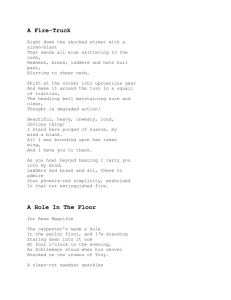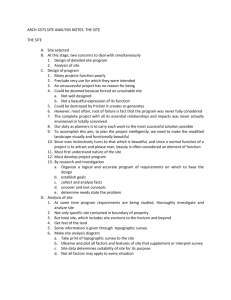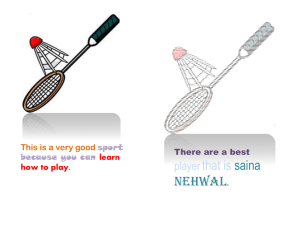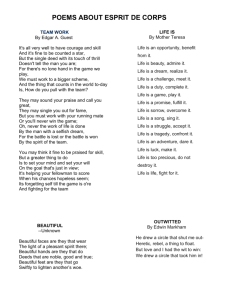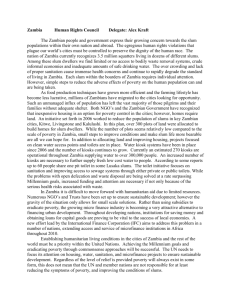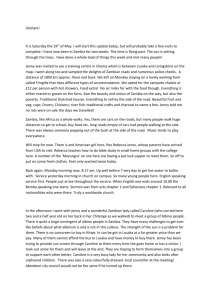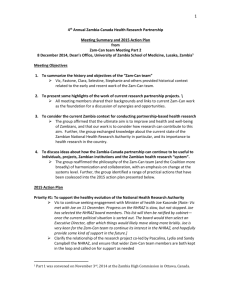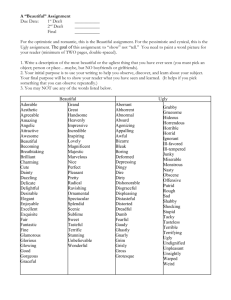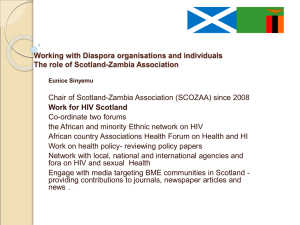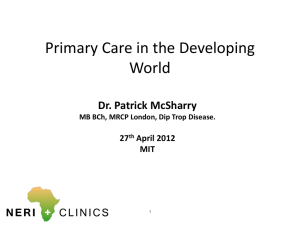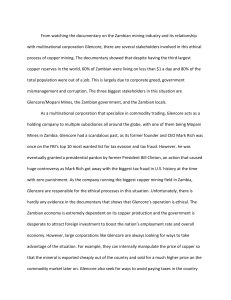printable version - Congregation of the Sisters of Mercy
advertisement
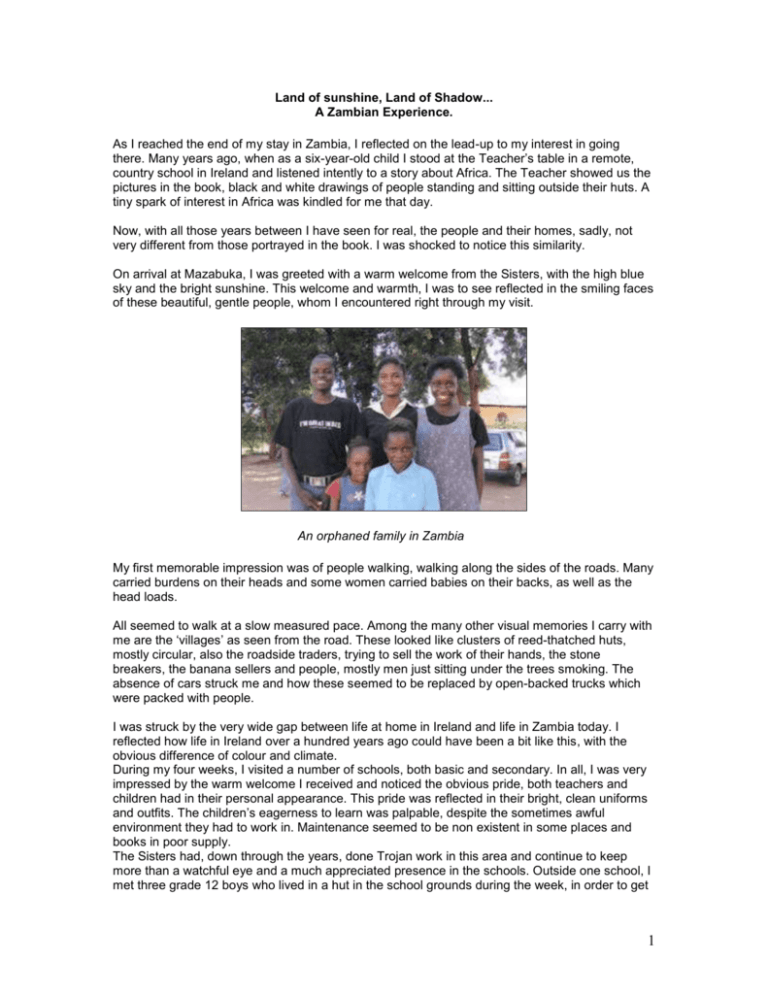
Land of sunshine, Land of Shadow... A Zambian Experience. As I reached the end of my stay in Zambia, I reflected on the lead-up to my interest in going there. Many years ago, when as a six-year-old child I stood at the Teacher’s table in a remote, country school in Ireland and listened intently to a story about Africa. The Teacher showed us the pictures in the book, black and white drawings of people standing and sitting outside their huts. A tiny spark of interest in Africa was kindled for me that day. Now, with all those years between I have seen for real, the people and their homes, sadly, not very different from those portrayed in the book. I was shocked to notice this similarity. On arrival at Mazabuka, I was greeted with a warm welcome from the Sisters, with the high blue sky and the bright sunshine. This welcome and warmth, I was to see reflected in the smiling faces of these beautiful, gentle people, whom I encountered right through my visit. An orphaned family in Zambia My first memorable impression was of people walking, walking along the sides of the roads. Many carried burdens on their heads and some women carried babies on their backs, as well as the head loads. All seemed to walk at a slow measured pace. Among the many other visual memories I carry with me are the ‘villages’ as seen from the road. These looked like clusters of reed-thatched huts, mostly circular, also the roadside traders, trying to sell the work of their hands, the stone breakers, the banana sellers and people, mostly men just sitting under the trees smoking. The absence of cars struck me and how these seemed to be replaced by open-backed trucks which were packed with people. I was struck by the very wide gap between life at home in Ireland and life in Zambia today. I reflected how life in Ireland over a hundred years ago could have been a bit like this, with the obvious difference of colour and climate. During my four weeks, I visited a number of schools, both basic and secondary. In all, I was very impressed by the warm welcome I received and noticed the obvious pride, both teachers and children had in their personal appearance. This pride was reflected in their bright, clean uniforms and outfits. The children’s eagerness to learn was palpable, despite the sometimes awful environment they had to work in. Maintenance seemed to be non existent in some places and books in poor supply. The Sisters had, down through the years, done Trojan work in this area and continue to keep more than a watchful eye and a much appreciated presence in the schools. Outside one school, I met three grade 12 boys who lived in a hut in the school grounds during the week, in order to get 1 an education. One of the boys told me he hoped to be a doctor. He has a long way to go but the ambition was there. Sr. Rose and friends at Victoria Falls At Nchete House called after the first Native Priest, many human and spiritual needs are catered for. While I was there, a one-day clinic was in progress for children and young adults who suffered various forms of disablement. The doctors came from Lusaka (Irish and English). Over a hundred mothers and babies and some older people waited for hours before the doctors came. Drinks were provided and the heat was intense, but nobody seemed to mind waiting. Nchete House also offers training in life skills, dressmaking, art and design and many others. Counselling and Spiritual Direction are offered by trained professionals. The Life Start Programme also housed in Machete House is in full swing and with their new premises built, (it was at floor level when I left) excitement was in the air. When I visited the compounds I saw the need and value of this Programme. However I was not prepared for what I would see on my first visit to the Compounds. After walking leisurely along the dusty road, between the waving fields of sugar – cane, I arrived at the Compound. Here was real poverty, extreme poverty in all its raw and degrading forms. I felt sad and helpless. Outside one hut I saw a woman, obviously sick and old beyond her years. She was lying on a sack on the ground with a pair of plastic sandals for a pillow. In another hut I met a young mother, with her infant, a little girl of three weeks old. The young mother placed her infant daughter in my arms with a proud and loving smile at her child her hope for the future. Some homes had little of life’s comforts, I saw only a few. But all the people radiated a certain joy and peace with great dignity. As we were leaving the Compound we had a following of up to twenty small children, scantily clad but all so beautiful. Sadly due to the Aid’s Pandemic in Zambia and to the sheer poverty infant mortality is around 50% a life expectancy in the adult is only 35 or 40 years. The country abounds with orphans being reared by older siblings or grandmothers. Prostitution is rampant. Some women, even the young sell their bodies for a few kwacha to buy food for their families or to buy an education. This is a glimpse of the shadow side of this beautiful land. Much is being done for these people by the Sisters and others and Aid comes to the country from further afield, but more is needed and as the Sisters know so well Education holds the key. . Celebration plays a major part in Zambian way of life. The Church Choirs robed in festive gear surpassed themselves around Easter, when I was privileged to be there and take part in the Holy 2 Week Ceremonies. The outdoor enactment of the Way of the Cross had for me, more than a feeling of being there on the First Good Friday — the hot sun, the dusty uneven ground, the very colour of the People in their bright costumes, all evoked an atmosphere of the Passion Scene. The Easter Night Ceremony, which included over a hundred Baptisms, was a devout celebration of unrestrained joy and enthusiasm. The Church was a sea of movement and colour — the dancers, the choir and the congregation all joining in this tremendous burst of joy in the Risen Lord. The land of sunshine was of course all around me every day with the beautiful blossoms on the flowering trees, the shrubs, the fruit in abundance on trees whose names I didn’t always know. The wild life I found interesting, not always attractive. The mosquitoes and the flying creatures were not my friends, and I feared the red and black ants at Buckley, the constant dread of a snake in the grass or a tree and towards the end of my visit, I learned the hard way to keep away from the goat, or at least to keep her at a distance and let her enjoy her life in the orchard! The music from the Compounds was always in the air, sometimes loud, but not at all unpleasant. In Kaleya, I liked the crickets, as they gave their full-throated performance at night. My visit to the Great Victoria Falls was an awesome experience. I remember so vividly the spray rising into the sky, visible from a distance, the thundering roar of the water and the sheer magic and mystery of God ever ancient, ever new at work in creation. I enjoyed that visit and as I stood on the Zambian/Zimbabwe Bridge, I caught the unforgettable sight of the circular rainbow way down below the bridge. My visit of four weeks came to a close a few days later. When I brushed the red Zambian dust from my shoes and bade farewell to that beautiful land of sunshine and shadow, prayed a blessing on those gentle People. Rose McQuaid rsm 3

